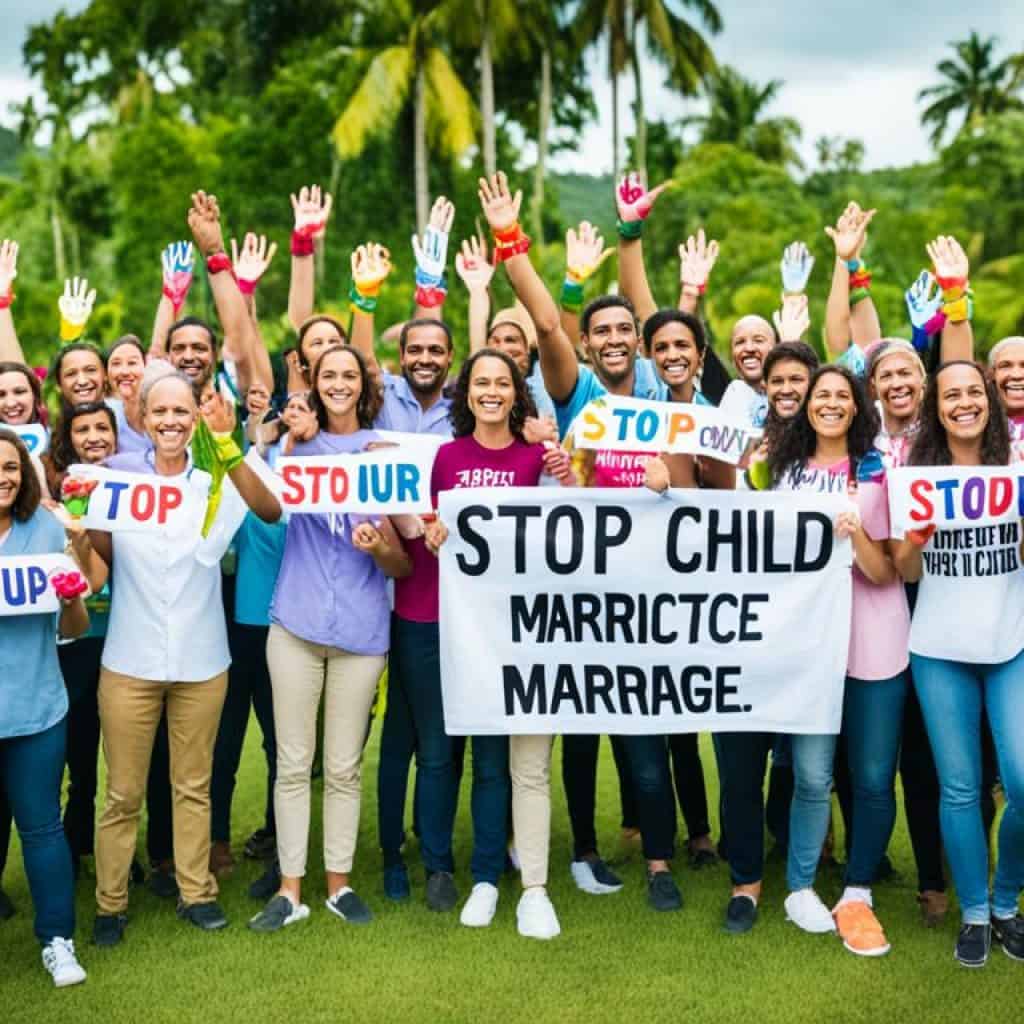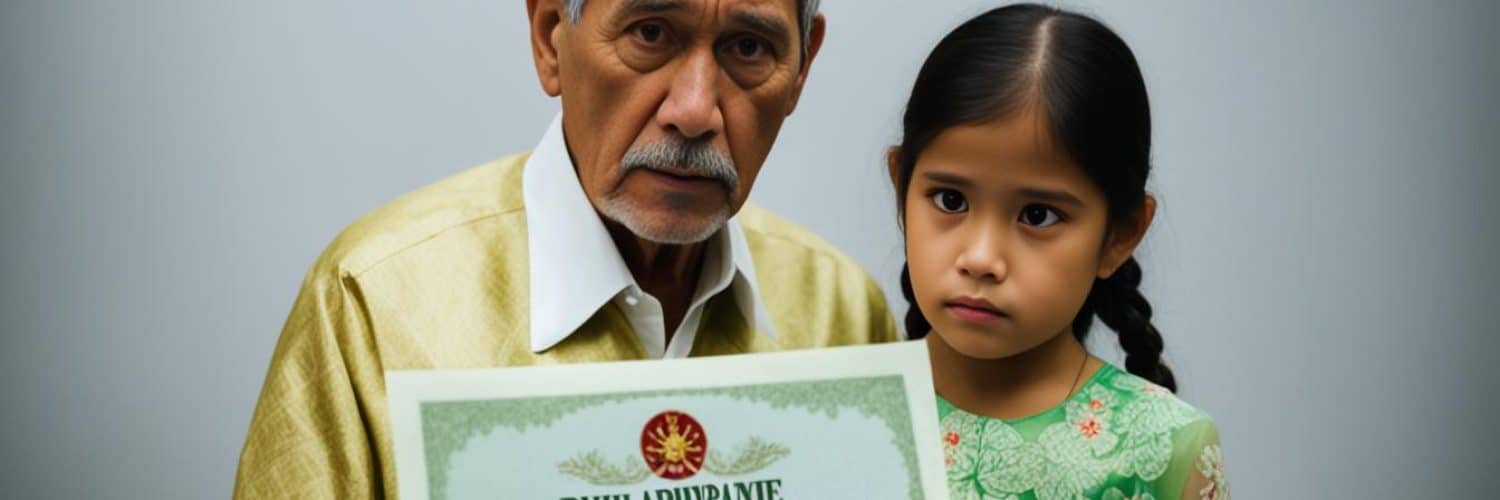Have you ever thought about why the Philippines, known for its lively culture and diversity, still has child marriage? This issue takes away young girls’ basic rights and leads to more human rights violations, discrimination, and inequality1. With over 650 million women worldwide who were child brides1, and the Philippines among the top 10 countries with the most child brides2, it’s time to focus on this big problem. We need to find ways to protect Filipino girls’ rights and futures.
Key Takeaways
- Child marriage is a big problem in the Philippines, with 16.5% of girls married before they turn 181.
- About one in six Filipino girls gets married before they are 181.
- Girls aged 15-19 in the Philippines who are married face a high risk of violence, including physical, sexual, or emotional abuse12.
- The Philippines has a new law, Republic Act No. 11596, that sets penalties for those who arrange or help with child marriages2.
- It’s important to tackle the reasons behind child marriage, like gender norms and stigma, to help girls and stop this harmful practice.
The Alarming Prevalence of Child Marriage in the Philippines
In the Philippines, child marriage is a big problem. The 2017 National Demographic and Health Survey found that about 17% of girls and 3% of boys got married before they were 183. This is especially true in indigenous and Muslim communities3.
Worldwide, the numbers are just as scary. Over 650 million women today were married as kids, and every year, 12 million girls, or 28 girls every minute, get married before they’re 183. This shows how many young girls lose their right to decide their own lives.
Disturbing Statistics on Child Brides
The Philippines is among the top countries for child marriages, says Plan International, a UK group4. One in six Filipino girls gets married before they’re 184. Also, 15% of young women aged 20-24 were married before they were 185.
Poverty makes child marriage more likely in the Philippines3. The COVID-19 pandemic has made things worse, with more teenage pregnancies expected due to lockdowns3. The Senate of the Philippines passed a bill against child marriage, but it’s still a big issue in some areas3.
Child marriage hurts children’s education and health3. The Child Rights Network, including World Vision Philippines, fights against child marriage3.
Even though the Philippines has banned child marriage, there’s still much to do to protect kids4. Stopping child marriage needs a big effort to fix the problems and help communities protect all children345.
Child Marriage: A Human Rights Violation
Child marriage is a serious violation of human rights. It takes away a girl’s childhood, education, and chances for growth6. In the Philippines, 1 in 6 girls get married before they turn 186. The country is ranked 12th in the world for child marriages6. This problem is mostly seen in indigenous and Muslim communities6.
The UN says child and forced marriage harm girls’ lives and futures6. It stops them from getting an education, makes them more likely to face violence, and keeps them from fully joining in society6. Girls who marry young often don’t stay in school6. They’re also more likely to face violence at home6.
In the Philippines, 26.4% of girls aged 15-19 who are married face violence from their partners6. Early marriage also raises the risk of health problems during pregnancy and childbirth6.
A new law in the Philippines aims to protect children from marriage6. But, the issue of child marriage and its effects on human rights is still big78.
“Child marriage threatens the lives and future of girls and women around the world.”
– United Nations Office of the High Commissioner on Human Rights
| Country | Percentage of Girls Married Before Age 18 | Rank in Global Child Marriage Prevalence |
|---|---|---|
| Bangladesh | 59% | 6th |
| India | 27% | 3rd |
| Nigeria | 44% | 11th |
| Philippines | 16% | 12th |
The numbers show child marriage is a big problem worldwide, with the Philippines being 12th in the number of cases68. We need to tackle this with laws, education, and community efforts to help girls and protect their rights867.
Philippines Child Marriage: Causes and Consequences
Child marriage in the Philippines is a big problem, caused by many factors. These include gender inequality, poverty, lack of education, and harmful social norms9. In the Bangsamoro Autonomous Region in Muslim Mindanao (BARMM), girls are often forced into marriage early. This is due to family, community, and environmental pressures9.
Parents may think child marriage keeps their daughters safe or helps their financial future. Societal norms and traditional gender roles also play a part in this issue9. Child marriage has serious effects, like early pregnancy and childbirth, higher risk of maternal death, sexual violence, and health problems10. It also stops girls from getting an education and good job chances, keeping them in poverty and inequality10.
The 2017 Philippine National Demographic and Health Survey found 1 in 6 girls are married by 1810. The Philippines is ranked 12th in the world for child marriages10. Girls who marry young are more likely to face domestic violence, abuse, and health issues during pregnancy and childbirth10. Babies born to these girls also face a high risk of death in the first month10.
The Philippines has passed a law against child marriage, which is a big win for young women and girls9. But, it’s important to make sure the law works well9. The study suggests we need to work together to stop child marriage. This includes helping girls stay in school, giving them access to education, and teaching parents about the dangers of child marriage9. Programs should also provide safe places for girls to learn and play, but we need more proof that these work9.
The problem of child marriage in the Philippines is complex, linked to societal norms, poverty, and lack of education for girls91011. To fix this, we need a plan that looks at the root causes and helps those affected. By empowering girls, building strong communities, and enforcing laws, we can help ensure every child can grow up free from child marriage.
A Legislative Victory: Republic Act No. 11596
In 2021, the Philippines made a big step by passing Republic Act No. 11596. This law bans child marriage12. It’s a big move to protect children’s rights and fight against child marriage.
Outlawing Child Marriage
This law says child marriage is any union with people under 18. It covers civil, religious, or traditional ceremonies13. Those who help or join in child marriages face heavy fines and jail time up to 12 years13.
The goal is to keep children safe from the bad effects of child marriage. This includes early pregnancy, missing school, and violence at home13. Lawmakers see this law as a big win in stopping child marriage and keeping kids safe.
Before this law, child marriage was a big problem in the Philippines122. One in six girls got married young, making the country rank high in child marriages12. Also, 15% of girls were married by 18, and 2% by 1512.
The law also calls for better sex education and awareness campaigns13. These efforts aim to change harmful beliefs and stop child marriage. By teaching people and changing attitudes, the Philippines hopes to empower young ones to choose their own paths.

Republic Act No. 11596 is a big win in fighting child marriage in the Philippines13. It shows the country’s commitment to its children’s rights and well-being. This law helps ensure all young Filipinos can grow and achieve their dreams.
Implementing the Law: Challenges and Opportunities
Republic Act No. 11596 made child, early, and forced marriage illegal in the Philippines14. But, making this law work is a big challenge. Groups like Oxfam Pilipinas and the Philippine Legislators’ Committee on Population and Development want to help. They aim to make people understand the law and its rules better14.
It’s important to change harmful social norms and set up prevention programs14. The Bangsamoro leaders don’t agree with the law, seeing child marriage as part of their tradition14. We need to work with these communities to make the law accepted everywhere.
Studies show it’s possible to stop child marriage in Mindanao, where it was common14. The Panginam (Hope) project helps by giving education to young girls and boys14. Scholars like Retired Professor Rufa Cagoco-Guiam are also helping by researching and solving problems in Mindanao14.
Worldwide, laws against child marriage face both hurdles and successes15. Countries like the Dominican Republic and the United States have banned child marriage, but enforcing these laws is hard16. The Philippines’ experience with Republic Act No. 11596 can teach other countries how to fight this issue15.
By tackling the challenges and using the chances this law offers, the Philippines can protect kids from child marriage. This can lead to a fairer and more just society1415.
“The implementation of laws such as RA 11596 is seen as a significant step in protecting Filipino children and creating a safer environment for them to enjoy their childhood and realize their full potential.”
philippines child marriage: A Global Perspective
The Philippines is working hard to stop child marriage, but it’s part of a bigger picture. Around the world, child marriage is going down, with fewer young women getting married early17. This is especially true in South Asia, where child marriage has fallen a lot17. But, the Philippines still has a lot of child brides, making it one of the top countries for this issue17.
Stopping child marriage is a big step, but it’s not enough. We need more support and programs to change harmful social norms and gender stereotypes17. The Philippines has made a big move by making child marriage illegal and punishing those who do it17.
But, there’s still a lot to do. About 15% of girls in the Philippines get married too young17. The country has a lot of child brides, with 726,000 cases reported17. We need a full plan to fix this, helping girls and women gain power.
| Child Marriage Statistics Globally | Data |
|---|---|
| Proportion of young women married as children decreased in the past decade | 15%17 |
| Risk of child marriage dropped in South Asia | More than a third17 |
| Philippines ranking in global number of child brides | 12th17 |
| Estimated percentage of Filipina girls married before 18 | 15%17 |
Over half a billion girls and women have been married too young, mostly in Africa and South Asia18. The Philippines is fighting this issue, and help from other countries is key to winning18.
Even with big steps like making child marriage illegal, there’s more work to do17. Some groups, like Muslims and indigenous communities, get a break on the new law18. We need a detailed plan to really change things, helping girls and women.
“Child marriage is a human rights violation that robs girls of their childhood and has lasting consequences on their health, education, and economic opportunities. Ending this practice is crucial for achieving gender equality and empowering women and girls.” – United Nations Children’s Fund (UNICEF)
The Philippines is pushing hard to stop child marriage, learning from the world and working with others1718. With the right programs and support, the country can protect young people’s rights and build a better future for everyone1718.
The Role of Education and Awareness
To stop child marriage in the Philippines, we need education and awareness. The new19 law, RA No. 11596, makes teaching about child marriage prevention a must in schools. This helps young people make better choices about their lives20. Studies show that staying in school longer lowers the chance of a girl marrying too young by six percentage points20.
Many girls leave school early and then get married. The COVID-19 pandemic made things worse, with girls facing more violence, exploitation, pregnancy, and forced marriage20.
Breaking the Cycle
Groups like Oxfam Pilipinas and the Philippine Legislators’ Committee on Population and Development are spreading the word about the new law21. They held sessions to teach people, especially young ones, about child marriage and its effects21. These talks covered how child marriage affects health and growth, and21 young people said they want to help stop it.
21 The campaign is part of the Creating Spaces project in Asia. It aims to lessen violence against women and girls and stop child marriage20. Child marriage often leads to early pregnancy, which means girls might not finish school20. Getting married young also means they’re unlikely to go back to school.
“We need to challenge the harmful social norms that perpetuate child marriage and empower girls and communities to prioritize education and autonomy over early marriage.”
These efforts are key to ending child marriage by tackling its causes and supporting girls in their education and growth19. The workshops bring together youth, parents, leaders, and others to create a plan to help19. Taking part are the DILG, NCIP, CPD, and DSWD Field Offices19.
Empowering Girls and Women
Helping girls and women is key to stopping child marriage in the Philippines. The Prohibition of Child Marriage Law (Republic Act No. 11596) sees women as vital for building the nation. It calls for ending unfair structures that keep women down22. Programs that give girls education, skills, and jobs help them dream of a life after early marriage22.
Changing community views on gender roles is also vital. This is especially true in Muslim areas like Maguindanao and Lanao del Sur, where many girls marry too young22. Around 88,600 child brides live there, mostly from poor families22.
The SHE Project works to empower women and girls in six areas of the Philippines22. It teaches them about their health and rights, aiming to stop early marriage22. Through peer education, it covers topics like menstruation care and child rights22.
Nana, a 17-year-old peer educator, has made a big impact. She stopped a friend from marrying early and fights misinformation online22. Despite the hurdles, Nana stays optimistic, inspired by her peers and the SHE Project’s work22.
Empowering girls and women is a moral and smart move for the Philippines’ future. By giving them education, skills, and jobs, and by changing gender views, we help them flourish23. This can end child marriage and lead to a fairer, wealthier future for everyone23.
“Education is not just about the mind – it’s about the heart. When you educate a girl, you educate a nation.”
The SWEET program helps women support their families and boost the economy23. By doing this, we help girls and women see a future beyond early marriage, ending child marriage in the Philippines23.
As we enforce the Child Marriage Law, focusing on empowering girls and women is crucial22. It protects their rights and lets them make a big difference in their communities and the country242223.
International Cooperation and Support
Ending child marriage in the Philippines needs help from around the world. The country is working with others to meet the United Nations’ goal of stopping child marriage by 2030. Groups like UNICEF and Girls Not Brides are giving money and advice to countries fighting this issue25. Right now, about 1 in 5 girls gets married too young, and 12 million girls marry each year25. With COVID-19, 10 million more girls might marry too young, making over 100 million girls marry early by 203025.
Working together and sharing what works can help the Philippines use its new law well. The Prohibition of Child Marriage Law aims to stop child marriage with laws, programs, and helping girls, giving them education and economic support26. We need ongoing support from around the world to protect girls’ rights in the Philippines and everywhere.
| Country | Child Marriage Rate | Initiatives to Address Child Marriage |
|---|---|---|
| Philippines | 261 in 6 Filipino girls get married before they turn 18 | 26Republic Act No. 11596 prohibiting child marriage, with a multi-sectoral approach involving partners and communities |
| Brazil | 27Brazil’s biggest retailer has intervened for almost 700 female employees in abusive relationships over the past four years | Initiatives to address child marriage and support women in abusive relationships |
| United States | 2744 states where child marriage is allowed, while it is outlawed without exceptions in states like New York, New Jersey, Delaware, Minnesota, Pennsylvania, and Rhode Island | Varying state-level laws on child marriage, with some states taking a stronger stance against the practice |
Working together is key to solving child marriage in the Philippines and globally. By sharing what works, giving resources, and building partnerships, we can help communities, protect girls and women, and end this harmful practice.27
“Ending child marriage is a global priority, and the Philippines’ new law is an important step forward. However, sustained international cooperation and support are needed to ensure this law is effectively implemented and its impact amplified across the country.”
Success Stories and Inspiring Initiatives
The fight to end child marriage in the Philippines is ongoing, but there are already success stories and initiatives to build upon. The passing of Republic Act No. 11596 was a big win, showing the government sees child marriage as a human rights issue28. Groups like Oxfam Pilipinas and the Philippine Legislators’ Committee on Population and Development are working hard to spread the word and make the law stronger28.
These efforts, along with the bravery of girls and women who’ve escaped child marriage, lay a strong foundation for progress28. For example, in South Asia, the chance of a girl marrying young has dropped by over a third, from nearly 50% to 30%29. In West and Central Africa, child marriage rates have cut in half in countries like Guinea-Bissau, Sierra Leone, and Gambia28.
Initiatives like Sabina’s work in Cambodia, using performance arts to prevent child marriage and violence, show the impact of community-led projects29. In Bangladesh, giving girls life skills and economic chances has helped lower child marriage rates29.
These stories and projects give us hope. They remind us that with teamwork, determination, and empowering girls and women, we can beat child marriage in the Philippines and elsewhere28.
| Country | Successful Initiatives |
|---|---|
| Bangladesh | Providing life skills and economic opportunities to reduce child marriage rates29 |
| Cambodia | Implementing comprehensive sexuality and reproductive health education in schools to lower child marriage rates29 |
| Philippines | Passing Republic Act No. 11596 to outlaw child marriage, and grassroots efforts by organizations like Oxfam Pilipinas and the Philippine Legislators’ Committee on Population and Development28 |
“With collective effort, determination, and the empowerment of girls and women, we can achieve a future free from the scourge of child marriage in the Philippines and beyond.”
The Way Forward: A Comprehensive Approach
To stop child marriage in the Philippines, we need a comprehensive, multifaceted approach. This means tackling social, economic, and cultural issues that keep it going30. We must focus on prevention, community work, and changing harmful gender views31.
It’s key to invest in girls’ education, economic power, and healthcare. Working together with the government, civil groups, and international partners is vital. We need to create strategies that help girls and change how society sees child marriage30.
Multifaceted Strategies
Stopping child marriage in the Philippines requires several important steps:
- Effective Implementation of Republic Act No. 11596: We need strong law enforcement and prevention efforts to stop child marriage31.
- Investment in Girls’ Education and Empowerment: Giving girls good education and job skills helps them delay marriage and find other paths30.
- Challenging Harmful Gender Norms: Awareness campaigns and community talks can change views that support child marriage30.
- Strengthening Access to Healthcare and Social Services: Offering health services and support can help girls at risk of child marriage30.
- Fostering Collaboration and Partnerships: Working together with different groups can help us make and carry out effective plans30.
With this comprehensive approach to end child marriage in the Philippines, we can empower girls and change society for the better3031.
“Ending child marriage requires a multifaceted strategy that addresses the root causes and empowers girls to choose their own path.”
The path to end child marriage is tough, but with a multifaceted strategy, we can do it. By working together, we can help girls and women in the Philippines reach their full potential303231.
Individual and Collective Responsibility
Stopping child marriage in the Philippines needs everyone to work together33. The law, Republic Act No. 11596, makes child marriage illegal. But, it’s up to communities, families, and us to change the social norms that let it happen34.
Everyone has a big role in this fight. Start by learning how child marriage hurts girls and why we must protect their rights35. By speaking out and supporting girls and women, you help change the culture33.
Working together is key34. We need to work with leaders, groups, and government to make the law work35. This way, we can make a place where child marriage is not accepted and kids are safe34.
Creating a culture of accountability is important for the Philippines33. With everyone’s effort, we can protect young people’s rights and futures35. This teamwork, based on personal commitment, will help end child marriage and let the next generation shine35.

“The abolition of child marriage is not just a legal imperative, but a moral and social obligation that we all share. Together, we can create a future where every child has the freedom to dream and the opportunity to thrive.”
Conclusion
The Philippines has made a big move to stop child marriage with a new law36. This law makes child marriage illegal and has tough rules for those who break it. Now, it’s important to make sure this law works well and keep working to help girls, change bad social ideas, and make everyone feel responsible37.
By taking action in many ways, like making laws, working with the community, and teaming up with other countries, the Philippines can lead in ending child marriage37. This will help protect the rights and future of young Filipinas. The journey might be tough, but the goal of a fairer and better future for everyone is worth it.
Working on the main reasons for child marriage, like poverty and gender bias, will help the Philippines support its young people37. This way, every girl will have a chance to succeed. With the help of the government, groups that help society, and partners from around the world, the Philippines can show the way in stopping child marriage and making a better future for its people.
FAQ
What is the prevalence of child marriage in the Philippines?
What are the human rights implications of child marriage in the Philippines?
What are the main drivers of child marriage in the Philippines?
What is the significance of the passage of Republic Act No. 11596 in the Philippines?
What are the key challenges in implementing the new child marriage law in the Philippines?
How does the Philippines’ effort to end child marriage fit into the global context?
What is the role of education and awareness-raising in addressing child marriage in the Philippines?
How can empowering girls and women help end child marriage in the Philippines?
How can international cooperation and support help the Philippines in its fight against child marriage?
Source Links
- https://newsinfo.inquirer.net/1846696/ending-child-marriage-in-ph-takes-more-than-a-law
- https://reproductiverights.org/philippines-criminalizes-child-marriage/
- https://www.worldvision.org.ph/end-child-marriage-2020/
- https://www.maryknollmagazine.org/2022/01/philippines-bans-child-marriage/
- https://reliefweb.int/report/philippines/empowering-maranao-girls-against-child-marriage
- https://reliefweb.int/report/philippines/passage-prohibition-child-marriage-law-major-milestone-child-rights
- https://newsinfo.inquirer.net/1838188/chr-forced-child-marriages-human-rights-violations-done-by-socorro-cult/
- https://www.hrw.org/world-report/2016/country-chapters/africa
- https://www.rappler.com/newsbreak/iq/things-to-know-causes-child-marriage-barmm/
- https://www.unicef.org/philippines/press-releases/passage-prohibition-child-marriage-law-major-milestone-child-rights
- https://reliefweb.int/report/philippines/girlsnotbrides-ending-child-marriage-philippines
- https://newsinfo.inquirer.net/1537254/new-law-bans-child-marriage-major-victory-vs-abuse-of-girls
- https://www.gmanetwork.com/news/topstories/nation/817190/bill-seeking-end-to-child-marriage-in-philippines-lapses-into-law/story/
- https://www.hurights.or.jp/archives/focus/section3/2022/06/enforcing-the-law-against-child-marriage.html
- https://www.worldvision.org.ph/world-vision-lauds-new-philippine-law-prohibiting-child-marriage/
- https://ecpat.org/story/international-women-and-girls-series-3-is-banning-child-marriages-enough/
- https://www.pgaction.org/news/senate-philippines-abolishes-child-marriage.html
- https://www.scmp.com/news/asia/southeast-asia/article/3162418/philippines-bans-child-marriage-it-debases-degrades-and
- https://www.dswd.gov.ph/dswd-development-partners-join-hands-to-curb-child-marriage/
- https://www.girlsnotbrides.org/learning-resources/child-marriage-and-education/
- https://www.plcpd.org.ph/plcpd-raises-awareness-on-child-marriage-urges-the-youth-to-stand-up-for-rights/
- https://philippines.oxfam.org/latest/image-story/how-bangsamoro-youth-help-prevent-child-marriages
- https://www.worldvision.org.ph/1000girls/
- https://philippines.unfpa.org/sites/default/files/pub-pdf/UNFPA_Policy_Brief_Child_Marriage_(2020-01-24) (2)_0.pdf
- https://plan-international.org/philippines/publications/our-voices-our-future/
- https://reliefweb.int/report/philippines/plan-international-celebrates-approval-philippine-law-prohibit-child-marriage
- https://www.linkedin.com/pulse/philippines-bans-child-marriage-zachary-karabell
- https://theprogressnetwork.org/philippines-child-marriage/
- https://plan-international.org/blog/2019/01/14/ending-child-marriage-is-possible-invest-in-whats-working/
- https://www.unwomen.org/sites/default/files/2023-09/legislating-and-enforcing-the-minimum-age-of-marriage-a-comparative-study-of-experiences-and-lessons-learned-en.pdf
- https://www.wcwonline.org/pdf/asia2007conf/Child Marriage and the Law.pdf
- https://www.ncbi.nlm.nih.gov/pmc/articles/PMC8550406/
- https://philippines.oxfam.org/latest/press-release/girl-defenders-alliance-welcomes-signing-irr-anti-child-marriage-law
- https://elibrary.judiciary.gov.ph/thebookshelf/showdocs/2/96305
- https://edcellagman.ph/speeches/speech-on-child-marriage
- https://www.dswd.gov.ph/dswd-spearheads-irr-signing-of-anti-child-marriage-law/
- https://www.rappler.com/voices/thought-leaders/opinion-changing-untold-narrative-child-brides/







Add comment